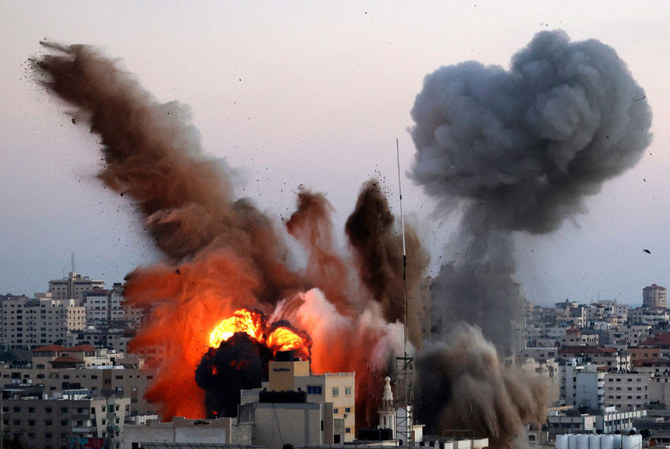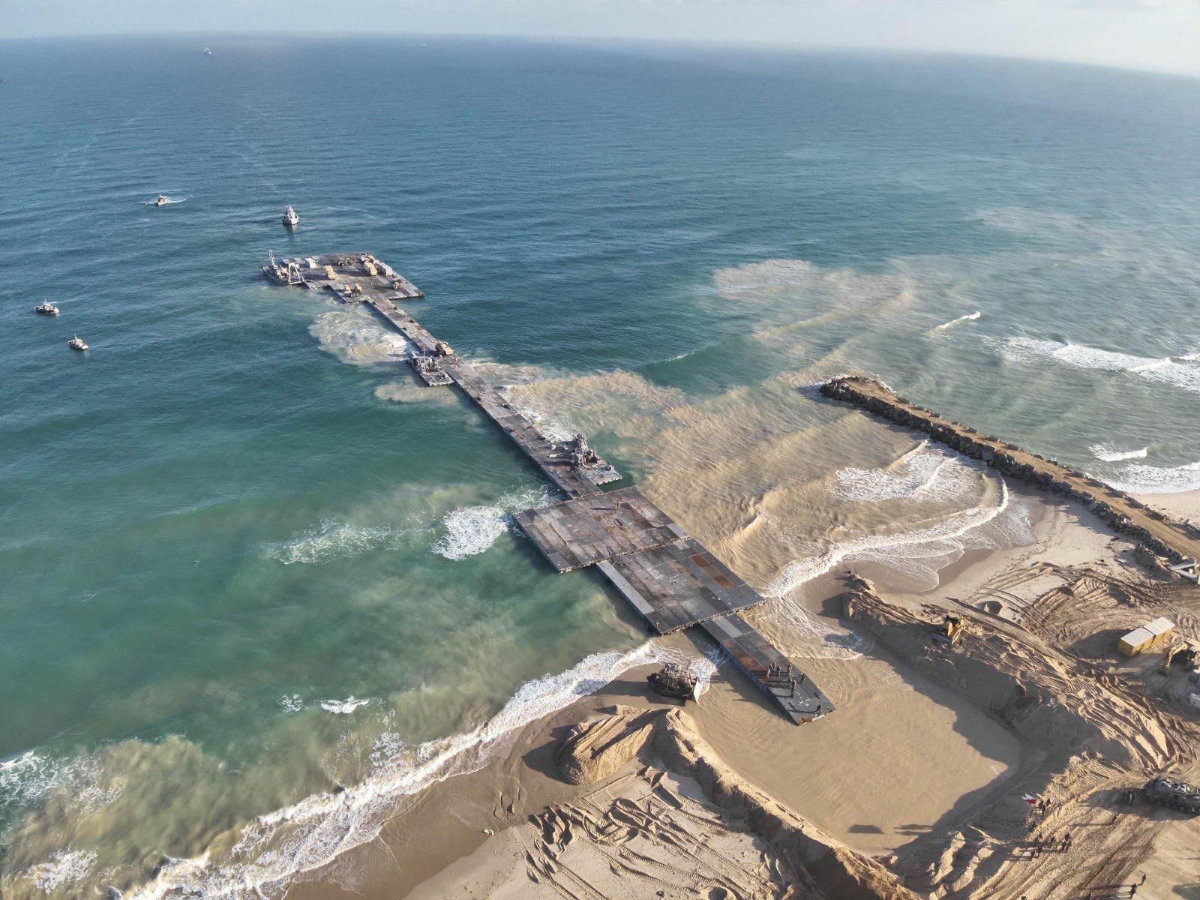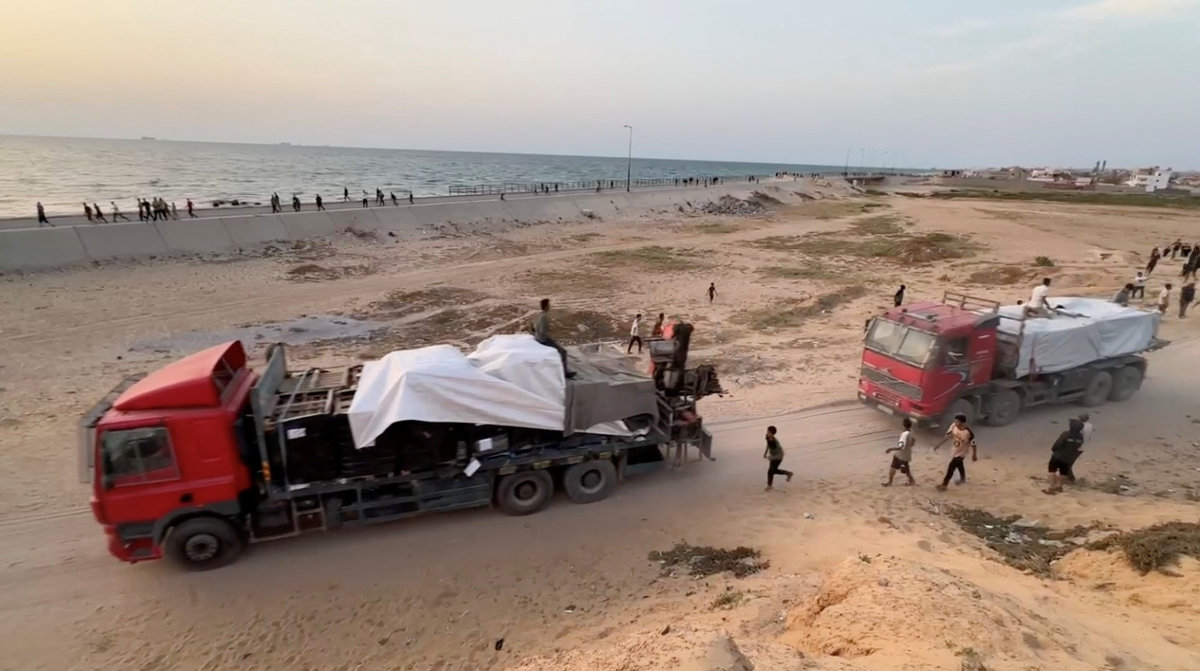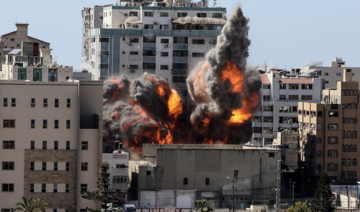JERUSALEM: Early Friday, just after midnight, the Israeli military put out an ominous statement to the media: “IDF air and ground troops are currently attacking in the Gaza Strip.”
The terse statement set off frenzied speculation that Israel had launched a ground invasion of Gaza — a much-feared scenario that would mark a bloody escalation of this week’s operation against Hamas militants. Some reporters were even told outright the incursion had begun.
Hours later, the military issued a “clarification.” There were no troops inside Gaza. But by then, several major news outlets had erroneously reported the ground offensive was under way.
While the army attempted to play down the incident as a misunderstanding, well-placed Israeli military commentators said the media had been used as part of an elaborate ruse to lure Hamas militants into a deadly trap that may have killed dozens of fighters.
“They didn’t lie,” said Or Heller, a veteran military correspondent on Israel’s Channel 13 TV. “It was a manipulation. It was smart and it was successful.”
This is how it unfolded:
Late Thursday, after days of airstrikes, Israel announced it was calling up thousands of reservists and amassing troops along the border ahead of a possible ground invasion. In another sign of escalation, Israeli tanks stationed along the border opened fire at targets inside Gaza.
In previous rounds of fighting, ground incursions have resulted in widespread destruction in Gaza and heavy casualties on both sides.
That set the stage for the late-night deception. According to Heller, Israel began scrambling forces along the border in what appeared to be final preparations for an invasion. Then came the announcement to the media, issued simultaneously in Hebrew and Arabic on Twitter. There followed alerts in major outlets that the invasion was under way.
The Israeli moves sent Hamas fighters rushing into defensive positions in an underground network of tunnels known as the Metro, according to Heller and other Israeli reports.
Israel called in 160 warplanes and bombarded the tunnels for 40 minutes, the military said. Heller said it was his understanding that scores of militants had been killed, though he said it was impossible to say.
“What we saw tonight was a very sophisticated operation that had a media aspect to it,” Heller said.
Hamas has not commented on the incident, and it was impossible to confirm the Israeli reports.
Heller said veteran Israeli correspondents, who have close ties to the military and in many cases have served themselves, knew that there was no way Israel was sending troops across enemy lines at this stage. Heller and other military correspondents even put out statements on Twitter assuring the jittery public that there was no ground operation.
The Associated Press, based on its analysis of the army’s statement, phone calls to military officials and on the ground reporting in Gaza, concluded there was no ground incursion and did not report there was one.
But others said the military had misled them or even lied when asked to clarify, turning the foreign media into an accessory of sorts.
Felicia Schwartz, correspondent for The Wall Street Journal, said she alerted news of a ground offensive after receiving explicit confirmation from Lt. Col. Jonathan Conricus, a military spokesman.
In a statement posted on Twitter, she said Conricus “told me directly, `There are ground troops in Gaza.’ That was the basis for a first story saying so. He retracted that statement two hours later and I changed the story to reflect that, and that is noted in the text and will be corrected.”
Speaking to reporters on Friday morning, Conricus blamed an “internal miscommunication.”
“These things can sometimes happen in the midst of a complex operation with many moving parts and with an unclear picture of what was happening,” he said. “As soon as I understood that I had the wrong information, I updated the relevant people with a clarification.”
Militaries around the world have long used deception and trickery against their enemies. Two years ago, the Israeli military reportedly faked the injuries of soldiers at the scene of a Hezbollah missile strike, going so far as to evacuate them to a hospital in a helicopter.
According to reports at the time, the army staged the injuries to trick Hezbollah into thinking it had inflicted casualties and therefore would agree to a cease-fire.
Friday’s misleading statement further strained what has often been a rocky relationship between the IDF and the foreign media.
Peter Lerner, a former military spokesman to the foreign media, said the Israeli public in general has long felt the international media focus too heavily on the Palestinian side of the story while minimizing Israeli concerns and suffering — and the army is similarly inclined.
Lerner said he felt it was unlikely the military intentionally lied, but damage was done regardless.
“Your currency is credibility,” he said. “I think this is a crisis of that credibility in the way it’s being portrayed.”
Israeli military accused of using media to trick Hamas militants in Gaza
https://arab.news/gcd5h
Israeli military accused of using media to trick Hamas militants in Gaza

- ‘It was not a lie. It was a manipulation,’ says Or Heller, a veteran military correspondent
- Ruse sent Hamas fighters rushing into an underground network of tunnels
Fierce fighting in northern Gaza as aid starts to roll off US-built pier

- Residents said Israeli bulldozers were demolishing homes and shops in Jabalia in the path of the advance
- In the south, Palestinian militants put up a fierce resistance, attacking tanks massing around Rafah
- Hamas says US floating aid pier is no substitute for end of Israeli siege of Gaza
CAIRO: Israeli forces battled Hamas fighters in the narrow alleyways of Jabalia in northern Gaza on Friday in some of the fiercest engagements since they returned to the area a week ago, while in the south militants attacked tanks massing around Rafah.
Residents said Israeli armor had thrust as far as the market at the heart of Jabalia, the largest of Gaza’s eight historic refugee camps, and that bulldozers were demolishing homes and shops in the path of the advance.
“Tanks and planes are wiping out residential districts and markets, shops, restaurants, everything. It is all happening before the one-eyed world,” Ayman Rajab, a resident of western Jabalia, said via a chat app.
Israel had said its forces cleared Jabalia months earlier in the Gaza war, triggered by the deadly Hamas-led attacks on southern Israel on Oct. 7, but said last week it was returning to prevent Islamist militants re-grouping there.
In southern Gaza bordering Egypt, thick smoke rose over Rafah, where an escalating Israeli assault has sent hundreds of thousands of people fleeing from what was one of the few remaining places of refuge.
“People are terrified and they’re trying to get away,” Jens Laerke, UN humanitarian office spokesperson, said in Geneva, adding that most were following orders to move north toward the coast but that there were no safe routes or destinations.
As the fighting raged, the US military said trucks started moving aid ashore from a temporary pier, the first to reach the besieged enclave by sea in weeks.
The World Food Programme, which expects food, water, shelter and medical supplies to arrive through the floating dock, said the aid was transported to its warehouses in Deir Al Balah in central Gaza and told partners it was ready for distribution.

The United Nations earlier reiterated that truck convoys by land — disrupted this month by the assault on Rafah — were still the most efficient way of getting aid in.
“To stave off the horrors of famine, we must use the fastest and most obvious route to reach the people of Gaza – and for that, we need access by land now,” deputy UN spokesperson Farhan Haq said.
US aid was arriving in Cyprus for delivery to Gaza via the new pier, Washington said.
Hamas demanded an end to Israel’s siege and accused Washington of complicity with an Israeli policy of “starvation and blockade.”
The White House said US national security adviser Jake Sullivan would visit Israel on Sunday and stress the need for a targeted offensive against Hamas militants rather than a full-scale assault on Rafah.
A group of US medical workers left the Gaza Strip after getting stuck at the hospital where they were providing care, the White House said.

Humanitarian fears
The Israel Defense Forces said troops killed more than 60 militants in Jabalia in recent days and located a weapons warehouse in a “divisional-level offensive.”
A divisional operation would typically involve several brigades of thousands of troops each, making it one of the biggest of the war.
“The 7th Brigade’s fire control center directed dozens of airstrikes, eliminated terrorists and destroyed terrorist infrastructure,” the IDF said.
At least 35,303 Palestinians have now been killed, according to figures from the enclave’s health ministry, while aid agencies have warned repeatedly of widespread hunger and dire shortages of fuel and medical supplies.
Israel says it must capture Rafah to destroy Hamas and ensure the country’s safety. In the Hamas attack on Oct. 7, 1,200 people died in Israel and 253 were taken hostage, according to Israeli tallies. About 128 hostages are still being held in Gaza.
Israel said on Friday that its forces retrieved the bodies of three people killed at the Nova music festival in Israel on Oct. 7 and taken into Gaza.
In response, Hamas said negotiations were the only way for Israel to retrieve hostages alive: “The enemy will not get its prisoners except as lifeless corpses or through an honorable exchange deal for our people and our resistance.”
Talks on a ceasefire have been at an impasse.
’Tragic war’
Israeli tanks and warplanes bombarded parts of Rafah on Friday, while the armed wings of Hamas and Islamic Jihad said they fired anti-tank missiles and mortars at forces massing to the east, southeast and inside the Rafah border crossing with Egypt.
UNRWA, the main UN aid agency for Palestinians, said more than 630,000 people had fled Rafah since the offensive began on May 6.
“They’re moving to areas where there is no water — we’ve got to truck it in — and people aren’t getting enough food,” Sam Rose, director of planning at UNRWA, told Reuters on Friday by telephone from Rafah, where he said it was eerily quiet.
At the International Court of Justice, or World Court, in The Hague, where South Africa has accused Israel of violating the Genocide Convention, Israeli Justice Ministry official Gilad Noam defended the operation.
The South African legal team, which set out its case for fresh emergency measures the previous day, framed the Israeli military operation as part of a genocidal plan aimed at bringing about the destruction of the Palestinian people.
WHO says no medical supplies received in Gaza for 10 days

GENEVA: The World Health Organization said Friday that it has received no medical supplies in the Gaza Strip for 10 days as Israel pursues a new offensive against Hamas.
Israel’s closure of the Rafah crossing into Gaza has caused “a difficult situation,” WHO spokesman Tarik Jasarevic said. “The last medical supplies that we got in Gaza was before May 6.”
Israeli troops entered the city of Rafah on May 7 to extend their offensive against Hamas over the militant group’s attacks seven months earlier. They closed the Rafah crossing into Egypt that is crucial for humanitarian supplies.
With UN agencies warning of a growing risk of famine in Gaza, the Kerem Shalom and Erez crossings from Israel are also virtually shut down.
Jasarevic said the biggest concern was over fuel needed to keep clinics and hospitals running. Gaza’s health facilities need up to 1.8 million liters of fuel a month to keep operating.
The spokesman said only 159,000 liters had entered Rafah since the border closure. “This is clearly not sufficient,” he added, highlighting how only 13 out of 36 hospitals across the Palestinian territory were now “partially” operating.
“Hospitals still functioning are running out of fuel, and that puts so many lives at danger,” said Jasarevic. “Current military operations in Rafah are putting countless lives at risk.”
The Hamas attack on October 7 resulted in the death of more than 1,170 people in Israel, most of them civilians, according to an AFP tally based on official Israeli figures. Out of 252 people taken hostage, 128 are still held inside Gaza, but the army says 38 have died.
More than 35,300 people, mostly civilians, have been killed in the Palestinian territory since the war broke out, according to data provided by the health ministry of Hamas-run Gaza.
Hezbollah uses new weapons in Israel attacks

- The Israeli army said three soldiers were wounded in an attack on Thursday
- Hezbollah has a large arsenal of weapons, that it has expanded significantly in recent years
BEIRUT: Lebanon’s powerful armed group Hezbollah announced on Thursday it had used a drone capable of firing rockets at a military position in one of its latest attacks in northern Israel.
Israel and Hezbollah have been involved in near-daily exchanges of fire since the war between Israel and Hamas broke out on October 7.
Hezbollah announced it had used an “armed attack drone” equipped with two S-5 rockets on a military position in Metula in northern Israel.
The Iran-backed group published a video showing the drone heading toward the position, where tanks were stationed, with the footage showing the moment the two rockets were released followed by the drone exploding.
It was the first time they had announced the use of this type of weapon since the cross-border exchanges with Israel erupted in October.
The Israeli army said three soldiers were wounded in Thursday’s attack.
Hezbollah-affiliated media said that the drone’s warhead consisted of between 25 and 30 kilogrammes (55 and 66 pounds) of high explosive.
Military analyst Khalil Helou told AFP that the use of drones offers Hezbollah the ability to launch the attack from within Israeli territory, as they can fly at low altitudes, evading detection by radar.
Hezbollah also announced on Wednesday that it had launched a strike using “attack drones” on a base west of the northern Israeli town of Tiberias.
That attack was the group’s deepest into Israeli territory since fighting flared, analysts said.
In recent weeks, the Lebanese militant group has announced attacks that it has described as “complex,” using attack drones and missiles to hit military positions, as well as troops and vehicles.
It has also used guided and heavy missiles, such as Iran’s Burkan and Almas missiles, as well as the Jihad Mughniyeh missile, named after a Hezbollah leader killed by Israeli fire in Syria in 2015.
Helou, a retired general, said that depite its new weaponry, Hezbollah still relied primarily on Kornet anti-tank missiles with a range of just five to eight kilometers.
They also use the Konkurs anti-tank missile, which can penetrate Israel’s Iron Dome defense system.
Hezbollah has a large arsenal of weapons, that it has expanded significantly in recent years.
The group has said repeatedly that it has advanced weapons capable of striking deep inside Israeli territory.
Analysts have described the skirmishes between Israel and Hamas as a war of “attrition,” in which each side is testing the other, as well as their own tactics.
Hezbollah has expanded the range of its attacks in response to strikes targeting its munitions and infrastructure, or its military commanders.
One such Israeli strike on Wednesday targeted the village of Brital in Lebanon’s eastern Bekaa Valley, with the Israeli army later announcing it had hit a “terror target related to Hezbollah’s precision missile project.”
Helou said Hezbollah’s targeting of the base near Tiberias and its use of the rocket-equipped drone “can be interpreted as a response to the attack on Brital, but it remains a shy response compared to the group’s capabilities.”
He suggested that the Israeli strike likely hit a depot for Iranian missiles that had not yet been used by Hezbollah.
“Hezbollah does not wish to expand the circle of the conflict,” Helou said.
“What is happening is a war of attrition through which it is trying to distract the Israeli army” from Gaza and seeking to prevent it from “launching a wide-ranging attack on Lebanon.”
US officials held indirect talks with Iran on avoiding regional escalation: report

Two top Biden administration officials held indirect talks with Iranian counterparts this week in an effort to avoid escalating regional attacks, Axios reported on Friday.
The conversations marked the first round of discussions between the US and Iran since January, according to Axios.
One Palestinian killed, eight wounded in Israeli strike on West Bank refugee camp

- Israel has killed more than 35,000 Palestinians, according to Gaza’s Health Ministry
RAMALLAH, West Bank: At least one person was killed and eight wounded on Friday in an Israeli air strike on the Jenin refugee camp in the occupied West Bank, the Palestinian health ministry and Israeli military said.
The Palestinian health ministry said the eight wounded people were in stable condition and receiving treatment at hospitals. Reuters could not immediately confirm their identities.
The Israeli military said a fighter jet conducted the strike, a rarity in the West Bank, where violence had been surging long before the Gaza war.
Residents of the refugee camp said a house was targeted.
The West Bank is among territories Israel occupied in a 1967 Middle East war. Palestinians want it to be the core of an independent Palestinian state.
















